Related Research Articles

Giovanni Battista Tiepolo, also known as GiambattistaTiepolo, was an Italian painter and printmaker from the Republic of Venice who painted in the Rococo style, considered an important member of the 18th-century Venetian school. He was prolific, and worked not only in Italy, but also in Germany and Spain.
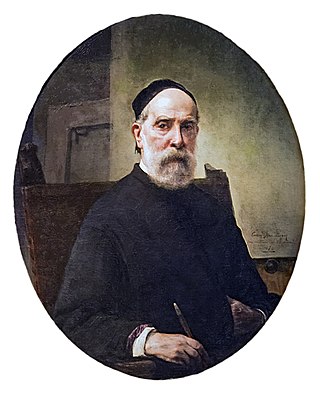
Francesco Hayez was an Italian painter. He is considered one of the leading artists of Romanticism in mid-19th-century Milan, and is renowned for his grand historical paintings, political allegories, and portraits.
Giovanni Balducci, called Il Cosci after his maternal uncle, was an Italian mannerist painter.

Giovanni Santi was an Italian painter, decorator, and the father of Raphael. He was born in 1435 at Colbordolo in the Duchy of Urbino. He studied under Piero della Francesca and was influenced by Fiorenzo di Lorenzo. He was court painter to the Duke of Urbino and painted several altarpieces. He died in Urbino.
Events from the year 1600 in art.

Giovanni Francesco Romanelli was a major Italian painter of the Baroque period, celebrated for his use of bright, vivid colors and also for his clarity of detail. Many of his works are on display in the Louvre.
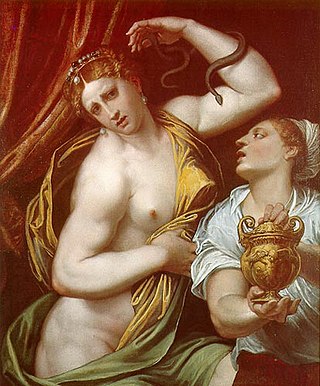
Domenico Riccio was an Italian painter in a Mannerist style from Verona, best known for frescos.
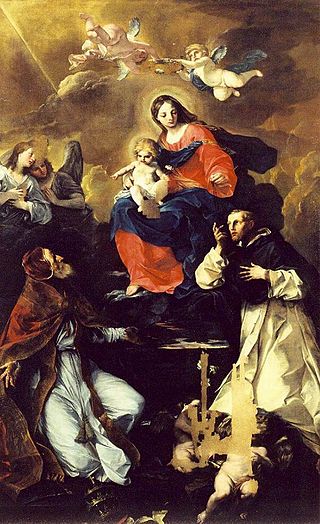
Felice Torelli was an Italian painter of the Baroque style, active mainly in Bologna.

Giovanni Bernardino Azzolini was an Italian painter and sculptor who continued painting in a late-Mannerist style, mainly active in Naples and Genoa. He is also known by Azzolino or Mazzolini or Asoleni.

Giovanni Paolo Cavagna was an Italian painter of the late-Renaissance period, active mainly in Bergamo and Brescia.
Events from the year 1560 in art.
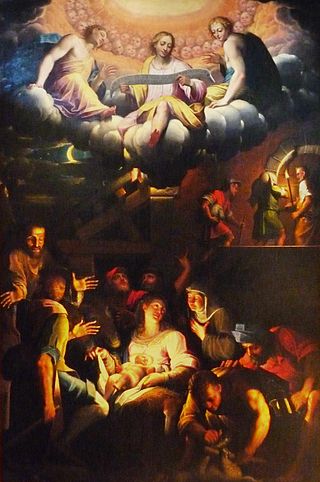
Giovanni Battista Trotti was an Italian painter of the late-Renaissance period, active mainly in Piacenza, Parma, and his native city of Cremona.
Balducci may refer to:

Venetian painting was a major force in Italian Renaissance painting and beyond. Beginning with the work of Giovanni Bellini and his brother Gentile Bellini and their workshops, the major artists of the Venetian school included Giorgione, Titian, Tintoretto (1518–1594), Paolo Veronese (1528–1588) and Jacopo Bassano (1510–1592) and his sons. Considered to give primacy to colour over line, the tradition of the Venetian school contrasted with the Mannerism prevalent in the rest of Italy. The Venetian style exerted great influence upon the subsequent development of Western painting.
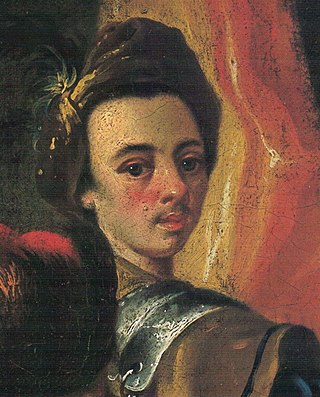
Johann Nepomuk della Croce was an Austrian painter, known in Italy as Giovanni Nepomuceno della Croce. He was active in both Germany and Trentino in a late-Baroque style, depicting portraits and religious subjects.

Volterra Cathedral is a Roman Catholic cathedral in Volterra, Italy, dedicated to the Assumption of the Virgin Mary. It is the seat of the bishop of Volterra.

The Oratory of Gesù Pellegrino, also called the Oratorio dei Pretoni, is a Roman Catholic prayer hall or small church found on the corner of Via San Gallo and via degli Arazzieri in Florence, region of Tuscany, Italy.

The Basilica of Santa Maria della Sanità is a basilica church located over the Catacombs of San Gaudioso, on a Piazza near where Via Sanità meets Via Teresa degli Scalzi, in the Rione of the Sanità, in Naples, Italy. The church is also called San Vincenzo or San Vincenzo della Sanità, due to the cult of an icon of San Vincenzo Ferrer, also called locally O' Monacone.

Bernardino Galliari (1707–1794) was an Italian painter, active mainly as a scenic designer and decorator of theaters.

Domenico Bruschi was an Italian painter and educator. Bruschi also designed tapestries, Renaissance revival wooden furniture, sculptures in stucco and stained glass windows. Bruschi served as the chair of Ornamentor at the Institute of Fine Arts in Rome, was made an official Academician of the Accademia di San Luca, and named Commandatore for his excellence in painting.
References
- Bryan, Michael (1886). Robert Edmund Graves (ed.). Dictionary of Painters and Engravers, Biographical and Critical. Vol. I: A-K. London: George Bell and Sons. p. 72.
- ↑ History of Painting in Italy: Umbrian & Sienese masters of the fifteenth century Volume 5, (1914); Publisher: Charles Scribner's and Sons, New York, page 420-421. By Joseph Archer Crowe, Giovanni Battista Cavalcaselle.